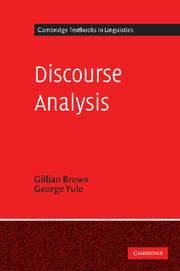Book contents
- Frontmatter
- Contents
- Preface
- Acknowledgements
- Transcription conventions
- 1 Introduction: linguistic forms and functions
- 2 The role of context in interpretation
- 3 Topic and the representation of discourse content
- 4 ‘Staging’ and the representation of discourse structure
- 5 Information structure
- 6 The nature of reference in text and in discourse
- 7 Coherence in the interpretation of discourse
- References
- Subject index
- Author index
- Frontmatter
- Contents
- Preface
- Acknowledgements
- Transcription conventions
- 1 Introduction: linguistic forms and functions
- 2 The role of context in interpretation
- 3 Topic and the representation of discourse content
- 4 ‘Staging’ and the representation of discourse structure
- 5 Information structure
- 6 The nature of reference in text and in discourse
- 7 Coherence in the interpretation of discourse
- References
- Subject index
- Author index
Summary
The term ‘discourse analysis’ has come to be used with a wide range of meanings which cover a wide range of activities. It is used to describe activities at the intersection of disciplines as diverse as sociolinguistics, psycholinguistics, philosophical linguistics and computational linguistics. Scholars working centrally in these different disciplines tend to concentrate on different aspects of discourse. Sociolinguists are particularly concerned with the structure of social interaction manifested in conversation, and their descriptions emphasise features of social context which are particularly amenable to sociological classification. They are concerned with generalising across ‘real’ instances of language in use, and typically work with transcribed spoken data. Psycholinguists are particularly concerned with issues related to language comprehension. They typically employ a tight methodology derived from experimental psychology, which investigates problems of comprehension in short constructed texts or sequences of written sentences. Philosophical linguists, and formal linguists, are particularly concerned with semantic relationships between constructed pairs of sentences and with their syntactic realisations. They are concerned, too, with relationships between sentences and the world in terms of whether or not sentences are used to make statements which can be assigned truth-values. They typically investigate such relationships between constructed sentences attributed to archetypal speakers addressing archetypal hearers in (minimally specified) archetypal contexts. Computational linguists working in this field are particularly concerned with producing models of discourse processing and are constrained, by their methodology, to working with short texts constructed in highly limited contexts.
Information
- Type
- Chapter
- Information
- Discourse Analysis , pp. viii - xPublisher: Cambridge University PressPrint publication year: 1983
